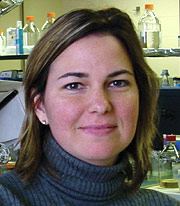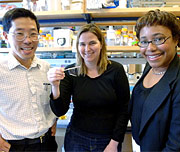Engineering viruses: using biology to assemble materials, devices
Building a battery
To create the first virus-based rechargeable battery, graduate student Kitae Nam used viruses to grow cobalt oxide on a copper surface and then added lithium on the other side. He worked at room temperature and used no toxic materials. The battery he produced looks just like Saran Wrap. It’s lightweight and flexible; its energy density is high due to its nano-scale structure; and it can be integrated into the device being powered, for example, as a coating on night-vision goggles or sewn into fabrics.
Belcher is now working with Professor Yet-Ming Chiang of materials science and engineering and Professor Paula Hammond of chemical engineering to make an even better battery. Hammond is creating a solid electrolyte from self-assembling polymers, and Belcher has developed viruses that will coat the top and bottom in monolayers to form the anode and cathode. The result: a battery that’s completely self-assembled.
Belcher’s group is already working on other energy-related technologies. They’ve built components for solar collectors—a challenge because of their large scale. And they’re beginning to think about how to make fuel cells.
In Belcher’s view, anything is possible. “I think we can apply our technologies to many other kinds of problems,” she said. Ideas include making organisms that would break down polymers to make fuels or that would incorporate carbon dioxide into their building material—a form of carbon sequestration.
Ultimately, she hopes to be able to biologically engineer the entire periodic table. “My goal is to have a DNA sequence that codes for the production of any kind of material I want,” she said. “You want a material to make some kind of object? Here’s the DNA sequence you need.”



